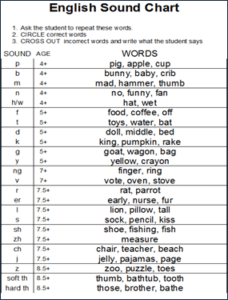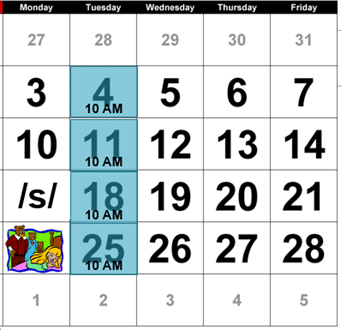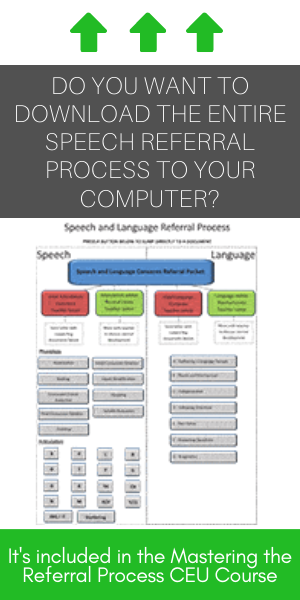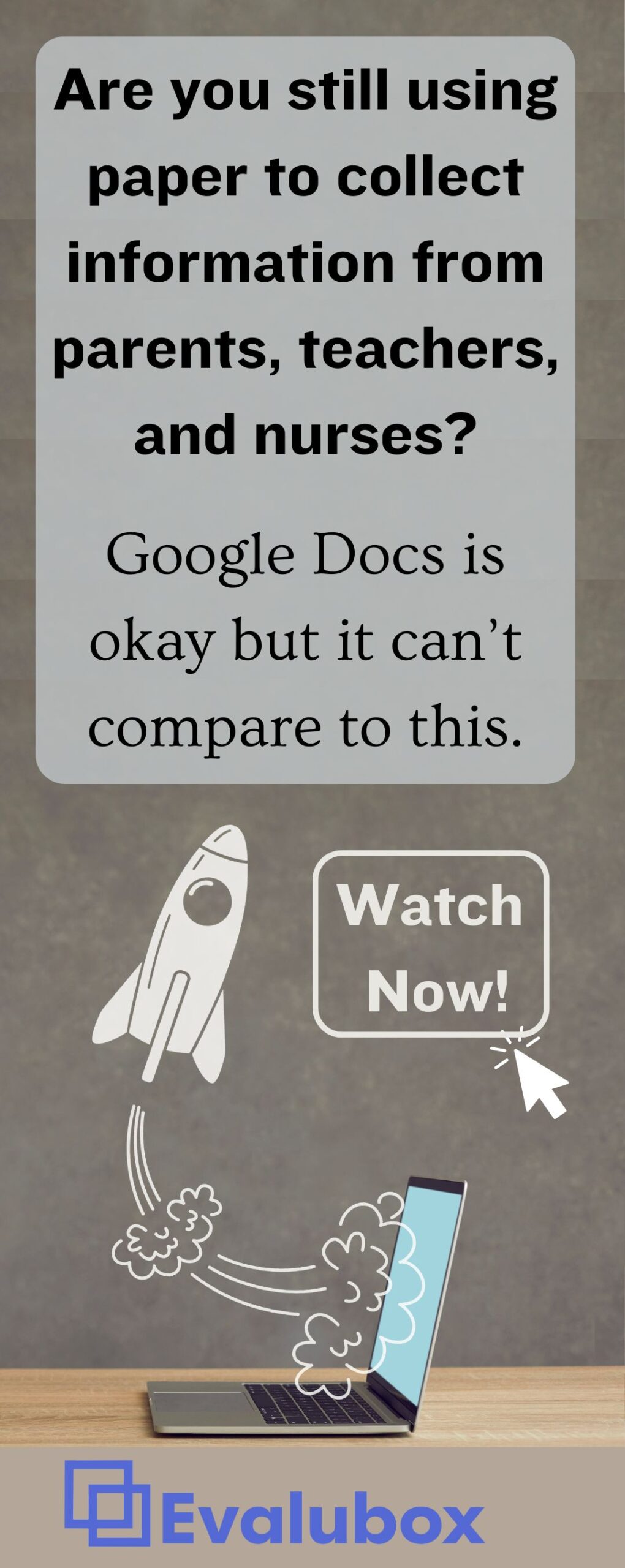Speech Therapy Referral Process
Is Your Speech and Language Referral Process Saving You Time, Improving Your Relationships with Teachers, and Getting You Better Referrals?
If not, you need these documents below.
A great speech therapy referral process can have a positive impact on your job and day-to-day interactions. What was once a cumbersome and dreaded process now alleviates speech referral problems rather than creating them.
We work across dozens of districts and hundreds of campuses and have tested the speech and language referral forms below until they rated high on the happy meter for teachers, administrators, and speech pathologists.
Just four pages from the speech referral checklist gets you ALL the information you need to create a solid referral. Then, targeting ONLY the area that the teacher is concerned about saves buckets of time.
The impact of effective speech therapy referrals
- Children get the services they need quickly
- Speech pathologists don’t evaluate students who do not qualify
- Teachers are not burdened by paperwork and can help their students
- The right children are entering special education
- Speech pathologists do not have children on their caseloads who shouldn’t be there
Press any button below to jump directly to a document
1- Print and give specific speech therapy referral forms to teachers when they voice concerns.
2- Respond to the teacher by letting them know that the concern is valid or that their student is within normal limits.
Indications for Making Speech Therapy Referrals for Young Children
Here are some quick guidelines for making speech therapy referrals for children below the age of four. By saying children have a “disorder” we are basically saying that their language or speech is not as developed as other children their age. It is helpful to know when abilities develop typically .
Speech Intelligibility
For parents: (Lynch, Brookshire & Fox, 1980)
- 18 months – ~25% intelligible
- 2 year olds – 50-75% intelligible
- 3 year olds – 75%-100% intelligible
For unfamiliar listener: (Flipsen, 2006)
- 18 months – ~25% intelligible
- 2 year olds – 50% intelligible
- 3 year olds – 75% intelligible
- 4 year olds – 100% intelligible
Vocabulary Development
- 12 months – first words (usually labeling familiar objects, and actions in child’s environment)
- 15 months – 4-6-word vocabulary
- 18 months – 20-50-word vocabulary
- 24 months – 200-300 word vocabulary
- 36 months – roughly 1000 words
- Overextensions (calling all men Dada)
- Underextensions (calling a tiger Kitty)
How to Make Your Speech and Language Therapy Referral Process Work for You
The speech and language referral process influences:
- How many children you see
- How big your caseload is
- How enjoyable your interactions are with teachers and other campus professionals.
For many speech-language pathologists, the speech referral process is more problematic than it is helpful. What is your opinion?
On one hand, we don’t want to participate heavily in the referral process because the workload is not often reflected in our caseload. By assuming a greater role in the speech therapy referral process we are also assuming the extra work. I have heard from speech-language pathologists who run “articulation groups” in the morning or at lunch. Others dedicate half a day each week to attend referral meetings. If a district captures this as part of the workload, good for you. However, for most of us this is not the case.
On the other hand, not participating in the speech therapy referral process often means that we will receive evaluation requests that may not actually be great referrals. An evaluation can take anywhere from 8 to 15 hours to observe, test, write, and meet with parents and teachers, only to find out that a child does not have an impairment in the area of communication. Teachers and parents have been waiting a long time for these results and are often expecting that services will be provided. Meeting to discuss results for a student who does not qualify for services can be extremely stressful to navigate and the teachers are often left feeling unsupported.
No involvement in the speech therapy referral process
+Less work and involvement in the referral process
-More speech referrals resulting in more evaluations, many of which may be for students that will not qualify
-Teachers and campus staff may feel unsupported
– meetings to explain the results of a student who did not qualify for services are often strained.
Higher involvement with speech therapy referrals
+ Better referrals which results in fewer evaluations
+ Teachers and campus staff feel supported.
-More work that is not reflected in our caseload numbers.
-More meetings to discuss a child’s progress through the referral process
How are we currently trying to solve the speech referral problem?
School districts across the country land somewhere on a spectrum ranging from full-involvement to non-involvement in the speech and language referral process. Those of us who have been working in the same district for a while have even seen the pendulum swing from one extreme to the other within the same district. Some districts adopt the Response to Intervention (RtI) model while others developed something unique (Student Success Team, Student Progress Monitoring, Database Decision Making…). Credit should be given for continually working on improvement in this all-too-important area but many of us have not arrived at a system that works.
Are we successful and are teachers referring the right students?
National statistics on over-identification do not bode well for the thirty-plus years that RtI has been in use. We continue to over-identify students for special education and in many locations our special education populations are disproportionately identifying children from diverse backgrounds (Skiba, Simmons, Ritter, Gibb, Rausch, Cuadrado, & Chung, 2008). We cannot blame the speech therapy referral process entirely without considering the dismissal process. However, there are a few simple ways we can change our referral process to improve the situation.
5 ways to improve your speech referrals with minimal involvement and simultaneously improve your relationship with teachers.
1. Involve Your Teachers in the Speech Referral Process
Cartwright-Gard, Harmon & Bryne (2002) surveyed teachers and found that 75% of teachers reported low confidence in making referrals AND that 80% indicated a desire for more training to improve their referrals. Their low confidence makes sense considering that most teachers receive less than two hours of training on communication each year. Conversely, teachers are huge advocates for their student’s success and also benefit from improved academic results when communication improves. We just need to change the terminology on our RtI pre referral speech and language checklist and give explicit instructions so that the teachers know exactly what to do.
Downloadable Presentation To Help Teachers Know Which Students to Refer for a Presentation
Script for Should I Refer This Bilingual Student for a Speech-Language Evaluation
2. Speak in Teacher-Friendly Terms
What do the teachers tell us most often? “I can’t understand my student.” To them, this is a singular “speech issue.” To us this can mean 27 common speech outcomes and/or 7 common language outcomes. Teachers can easily gather information with the speech therapy referral form template above (blue button) and you get lists of words that are said in error, sentence examples, and descriptions of social interactions. We then use our speech brains to determine the nature of the difficulty. We would not be expected to diagnose reading and writing difficulties. They should not be expected to make determinations within our profession.
There are at least 27 ways a child can make a sound error and 7 ways to make a language error
3. Use Explicit Instructions in the Teacher Referral Form for Speech Therapy

“No, have the student say the sound,” I responded.
“Why don’t you just put say then?” she retorted, reasonably. Point taken.
As SLPs we love our SLP jargon but we need to adopt language that everyone can understand. Here is a speech therapy referral form template for articulation with explicit instructions. You can see that from 5 minutes of effort on their part, you will have the initial information about which sounds are being produced in error, in what size words, and what is expected for their age.
4. Only Request Needed Information
We conduct evaluations across dozens of districts and see immense variety in the amount and type of information that is requested for speech and language referrals. Many teachers have a really poor opinion of the speech and language therapy referral process because of the perceived (or real) burden on their part. The truth is that we only need 7 pieces of information to get the ball rolling.
The teacher questionnaire for speech language referrals should really only include:
- Name
- Date of Birth
- Grade
- Teacher
- Vision and Hearing status
- Parent Concern and History
- Teacher Concern
- I can’t understand my student – Speech examples
- My student doesn’t speak enough, is confusing, or can’t understand me – Language examples
Only request information that will inform your decision about whether or not the child will need testing. Yes, a full evaluation will require much more information but that is not our concern at this point in the process.
5. Keep Time on Your Side

- I find a time that works for a teacher, let’s say 10AM on Tuesday. We meet and I ask her to provide the 7 pieces of information above and ask to meet next week at the same time.
- Sometimes when I come back the information for the rti pre referral speech and language checklist has not been gathered. I take this as a sign that I did not explain it well enough and I show her how to gather the information. This may take 10 minutes but I immediately win a fan of the process, reduce the teacher’s fears, and give her the information she needs to do all future speech referrals.
- I examine her results and next week return with requests to gather more specific information. Let’s say that the child could not say /s/ on the initial screener. I return with a speech therapy referral form template (above) for initial, medial, final, and cluster /s/ words and ask her to have the child repeat the sound. This gives me accurate percentage data.
- Lastly, ask which topics they are working on in the classroom and look for a way to practice the sound. As an example, if they are reading Goldilocks and the Three Bears I could highlight all the words with /s/ and also send copies home to practice.
- By the end of three or four 10-minute visits, you will have great data and a pretty good idea about whether the child is stimulable for the error in their natural environment or if they need specific help. This can go on as long as the child continues to make progress in the classroom.
So that’s it in a nutshell. Many times we spend 30 minutes on the front end and avoid 10 hours on the back end. And that’s a pretty good trade off.
Additional References to Make a Referral to Speech Therapy
Scott Prath published an article in the October ASHA Leader–Make the Speech Referral Process Work for You. In it, he included a link to our free referral documents.
What are the Indications for a Referral to Speech Therapy?
Guidelines for Referral: Medical
Skiba, R. J., Simmons, A. B., Ritter, S., Gibb, A. C., Rausch, M. K., Cuadrado, J., & Chung, C. G. (2008). Achieving equity in special education: History, status, and current challenges. Exceptional Children, 74(3), 264-288.
Featured Course
Master Your Speech and Language Therapy Referral Process

Not only that, includes all of the spreadsheets, forms, and speech therapy referral letters you need for teachers.
AND as a bonus! It includes the 57 pages that make up the process above for you to download to your desktop.
Mastering the Referral Process – Better Referrals, Data, and Collaboration







